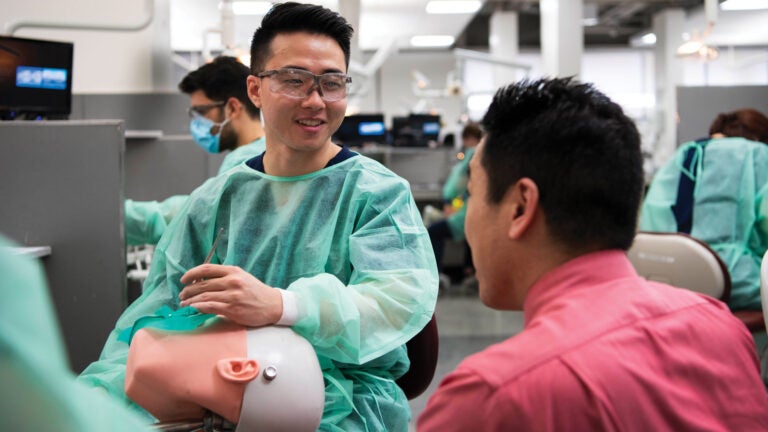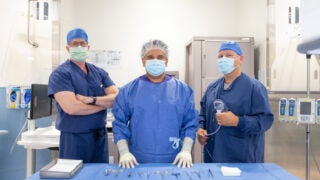
Nicholas Tan, left, learns the importance of proper ergonomics and building solid habits from instructor Kenneth Kim. (Photo/Hannah Benet)
Novel partnership helps students deal with physical stress caused by dentistry
A collaboration between the university’s physical therapy and dentistry programs leads to more work with less pain
Minalie Jain had experienced pain before, but when she started to work in the simulation lab at USC, the shooting pain in her arm caught her attention.
The sim lab involves a lot of fine handwork, with students bent over molds of teeth. The intensity of the muscle contractions left Jain in stabbing and throbbing pain.
Fortunately for her, the Herman Ostrow School of Dentistry of USC and the university’s physical therapy program have teamed up to use physical therapy skills that can help dental students deal with the physical stress caused by dentistry. Jain now does physical therapy to help her in day-to-day work.
Physical stress: Ergonomics and body mechanics offer relief
Dental students had always had one lecture on ergonomics from a physical therapy professor, but when Kenneth Kim, instructor of clinical physical therapy, took over that lecture, he thought the schools could do more together.
“I felt like a lecture once a year wasn’t enough — especially because we were seeing so many dental students at the clinic,” he said. “Sometimes the students were getting pretty emotional because of all the pain.”
Kim worked with Jin-Ho Phark, associate professor of clinical dentistry, to set up the ergonomics and body mechanics collaboration after the lecture. This is the first year that physical therapy students go to the dental students’ sim lab once a week, for two hours in the morning and two hours in the afternoon. “We can follow up on body position and patient position, and they have been really receptive,” Kim said.
The biggest issues that dental students face are forces on their hands, necks and arms as they work on models of patients.
They sometimes forget to adjust the patient to make their own bodies work more easily.
Kenneth Kim
“They sometimes forget to adjust the patient to make their own bodies work more easily,” Kim said. “That means that students can stay hunched over, in that position for hours, which causes neck and back pain. We come in and make a small adjustment, which results in a huge outcome.”
Musculoskeletal disorders: a widespread problem
Dentists are particularly prone to musculoskeletal disorders: 70 percent of dentists suffer from them, compared to 12 percent of surgeons. That’s mainly because dentistry requires lots of repetitive motions, especially by the hand and wrist, as well as sustained postures, said Phark says, who explained that students in the sim lab work on mannequins, learning to use drills inside tooth models. The way they position their necks forward or slouch their backs can often result in lower back and shoulder pain.
“We see that throughout the years students in dental school don’t always take care of their posture while they perform procedures,” he said. That’s hard on a body, especially considering students are working in the same position for eight hours a day.
In addition to the lectures and hands-on help, students can often position themselves better by using their loupes, which allows them to maintain a certain distance from a patient.
“With lenses on the loupes, you can’t really adjust them so there is a working length in which they have to position themselves,” Phark said.
Sit for some patients and stand for others
Kenneth Gozali uses his loupes to remind himself to keep a good posture and position with patients. He focuses on sitting straight, having the right chair height and patient height — all of which make it easier to do his work.
“It was a little strange because I was not all that used to sitting all day, but now I like to switch it up: I’ll sit down for two or three patients and then stand up for the next ones,” he says, adding that in dentistry it’s all about keeping your hands and arms in good working order. “You can’t do much with a bad back or bad arm.”
Phark has used the collaboration as a refresher in his own work: He noticed there were days when he came home in pain.
“My back is hurting, my neck is hurting, I have to maintain a proper posture myself,” he said. “It’s not just preaching — we have to practice ourselves.”
Phark works on Wednesdays in the USC Dental Faculty Practice for 12 hours. “I basically cannot survive the day if I’m not sitting properly,” he said.
Two-way education
The dental students have been very receptive to the instruction and advice, since many of them experience a variety of issues that we can help them navigate and problem solve, whether it is pain, fatigue or difficulty visualizing target areas within the mouth, said Ashley Wallace, who has also learned things from the dental students
“I’ve learned the dentistry-specific language in regards to quadrants and tooth surfaces, and how the position of both the patient and dentist change depending on the target surface, procedure and tools required or whether direct or indirect vision is used.”
Wallace said it’s been valuable to adapt her training to a specific audience such as the dental students.
“My hope is that if they implement proper body mechanics now, they will have less need for physical therapy down the road.”
It takes three weeks to break a habit
Kim hopes to continue and expand the collaboration in the coming years. This year, physical therapy students are only working in the dental school for five weeks — and they are trying to figure out how to do more in the future.
“For the first year, five weeks is pretty good,” Kim said. “It takes three weeks to break a bad habit, like slouching or stooping. With our presence, we can get them to be more mindful about their posture going forward.”
Jain will continue to do physical therapy exercises, which she said are helping her pain. An X-ray showed calcified tendonitis in her rotator cuff, a genetic condition that was exacerbated by her dental school work. She’s grateful for the extra perspective and help she gained from the collaboration.
“Ergonomics is very crucial in dental school because forming a bad habit is really easy since it is very difficult seeing in the mouth,” she said. “It is important to keep the back straight and the arms in appropriate positioning so it doesn’t cause strain on it, even for people who do not have arm issues.”



